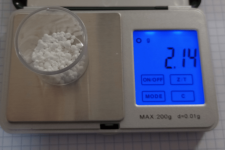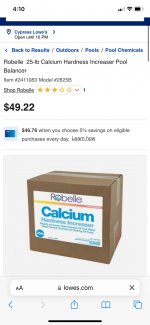I did a bucket test. Used Hy-Clor Calcium Increaser from our local Hardware store. Also bought two new buckets. Filled them with 8L of pool water (11.6°C or 53°F, still winter here). FC in both buckets 9ppm, CC below 0.5ppm, CH 375ppm, CYA 50ppm.
Then I added about 2.1g of Calcium Increaser to one bucket. For this brand I usually assume a mix of 1/3 anhydrous and 2/3 dihydrate, so that should increase CH by about 200ppm.
View attachment 448044
I tested the water about 15min, 40min and 13h (next morning) after the addition. CH confirmed at 575ppm as expected.
In the reference sample, FC remained pretty much unchanged at 9ppm, no change in CC as well (wouldn't make sense anyway with FC unchanged).
In the Calcium Increaser sample, there was an initial small drop to FC 8.5ppm, no change in CC. That number remained constant until the final measurement in the morning.
All in all a small effect (0.5ppm decrease in FC) after a significant addition of Calcium Chloride (the amount I added would be equivalent to adding nearly 18kg to my 66kL pool, nothing I would ever recommend doing). Normally, I would increase my CH in 25ppm steps, where the FC decrease should scale down to less than 0.1ppm, pretty much not detectable.



